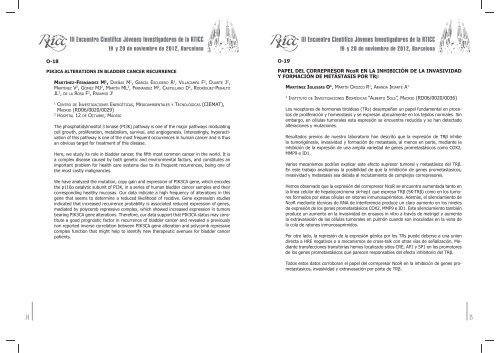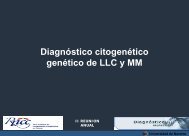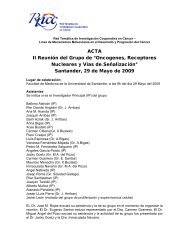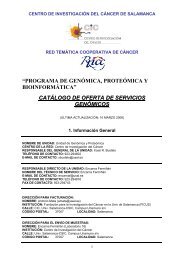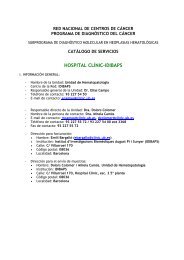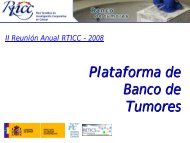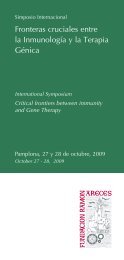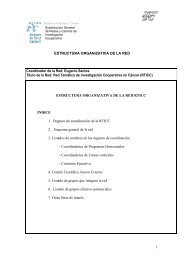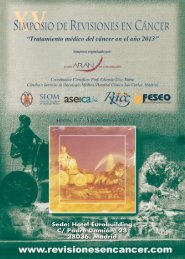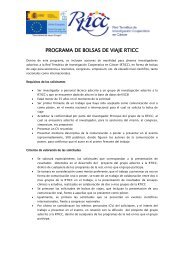Untitled - Red Temática de investigación cooperativa en cáncer
Untitled - Red Temática de investigación cooperativa en cáncer
Untitled - Red Temática de investigación cooperativa en cáncer
Create successful ePaper yourself
Turn your PDF publications into a flip-book with our unique Google optimized e-Paper software.
O-18<br />
PIK3CA ALTERATIONS IN BLADDER CANCER RECURRENCE<br />
MARTÍNEZ-FERNÁNDEZ M 1 , DUEÑAS M 1 , GARCÍA ESCUDERO R 1 , VILLACAMPA F 2 , DUARTE J 2 ,<br />
MARTÍNEZ V 2 , GÓMEZ MJ 2 , MARTÍN ML 2 , FERNÁNDEZ M 2 , CASTELLANO D 2 , RODRÍGUEZ-PERALTO<br />
JL 2 , DE LA ROSA F 2 , PARAMIO J 1<br />
1<br />
CENTRO DE INVESTIGACIONES ENERGÉTICAS, MEDIOAMBIENTALES Y TECNOLÓGICAS (CIEMAT),<br />
MADRID (RD06/0020/0029)<br />
2<br />
HOSPITAL 12 DE OCTUBRE, MADRID<br />
The phosphatidylinositol 3 kinase (PI3K) pathway is one of the major pathways modulating<br />
cell growth, proliferation, metabolism, survival, and angiog<strong>en</strong>esis. Interestingly, hyperactivation<br />
of this pathway is one of the most frequ<strong>en</strong>t occurr<strong>en</strong>ces in human cancer and is thus<br />
an obvious target for treatm<strong>en</strong>t of this disease.<br />
Here, we study its role in blad<strong>de</strong>r cancer, the fifth most common cancer in the world. It is<br />
a complex disease caused by both g<strong>en</strong>etic and <strong>en</strong>vironm<strong>en</strong>tal factors, and constitutes an<br />
important problem for health care systems due to its frequ<strong>en</strong>t recurr<strong>en</strong>ces, being one of<br />
the most costly malignancies.<br />
We have analyzed the mutation, copy gain and expression of PIK3CA g<strong>en</strong>e, which <strong>en</strong>co<strong>de</strong>s<br />
the p110α catalytic subunit of PI3K, in a series of human blad<strong>de</strong>r cancer samples and their<br />
corresponding healthy mucosas. Our data indicate a high frequ<strong>en</strong>cy of alterations in this<br />
g<strong>en</strong>e that seems to <strong>de</strong>termine a reduced likelihood of recidive. G<strong>en</strong>e expression studies<br />
indicated that increased recurr<strong>en</strong>ce probability is associated reduced expression of g<strong>en</strong>es,<br />
mediated by polycomb repressive complex, which showed increased expression in tumors<br />
bearing PIK3CA g<strong>en</strong>e alterations. Therefore, our data support that PIK3CA status may constitute<br />
a good prognostic factor in recurr<strong>en</strong>ce of blad<strong>de</strong>r cancer and revealed a previously<br />
non reported inverse correlation betwe<strong>en</strong> PIK3CA g<strong>en</strong>e alteration and polycomb repressive<br />
complex function that might help to i<strong>de</strong>ntify new therapeutic av<strong>en</strong>ues for blad<strong>de</strong>r cancer<br />
pati<strong>en</strong>ts.<br />
O-19<br />
PAPEL DEL CORREPRESOR NcoR EN LA INHIBICIÓN DE LA INVASIVIDAD<br />
Y FORMACIÓN DE METÁSTASIS POR TRβ<br />
MARTÍNEZ IGLESIAS O 1 , MARTÍN OROZCO R 1 , ARANDA IRIARTE A 1<br />
1<br />
INSTITUTO DE INVESTIGACIONES BIOMÉDICAS “ALBERTO SOLS”, MADRID (RD06/0020/0036)<br />
Los receptores <strong>de</strong> hormonas tiroi<strong>de</strong>as (TRs) <strong>de</strong>sempeñan un papel fundam<strong>en</strong>tal <strong>en</strong> procesos<br />
<strong>de</strong> proliferación y homeostasis y se expresan ubicuam<strong>en</strong>te <strong>en</strong> los tejidos normales. Sin<br />
embargo, <strong>en</strong> células tumorales esta expresión se <strong>en</strong>cu<strong>en</strong>tra reducida y se han <strong>de</strong>tectado<br />
alteraciones y mutaciones.<br />
Resultados previos <strong>de</strong> nuestro laboratorio han <strong>de</strong>scrito que la expresión <strong>de</strong> TRβ inhibe<br />
la tumorigénesis, invasividad y formación <strong>de</strong> metastasis, al m<strong>en</strong>os <strong>en</strong> parte, mediante la<br />
inhibición <strong>de</strong> la expresión <strong>de</strong> una amplia variedad <strong>de</strong> g<strong>en</strong>es prometastásicos como COX2,<br />
MMP9 e ID1.<br />
Varios mecanismos podrían explicar este efecto supresor tumoral y metastásico <strong>de</strong>l TRβ.<br />
En este trabajo analizamos la posibilidad <strong>de</strong> que la inhibición <strong>de</strong> g<strong>en</strong>es prometastasicos,<br />
invasividad y metastasis sea <strong>de</strong>bida al reclutami<strong>en</strong>to <strong>de</strong> complejos correpresores.<br />
Hemos observado que la expresión <strong>de</strong>l correpresor NcoR se <strong>en</strong>cu<strong>en</strong>tra aum<strong>en</strong>tada tanto <strong>en</strong><br />
la línea celular <strong>de</strong> hepatocarcinoma sk-hep1 que expresa TRβ (SK-TRβ) como <strong>en</strong> los tumores<br />
formados por estas células <strong>en</strong> ratones inmunosuprimidos. A<strong>de</strong>más, el sil<strong>en</strong>ciami<strong>en</strong>to <strong>de</strong><br />
NcoR mediante técnicas <strong>de</strong> RNA <strong>de</strong> interfer<strong>en</strong>cia produce un claro aum<strong>en</strong>to <strong>en</strong> los niveles<br />
<strong>de</strong> expresión <strong>de</strong> los g<strong>en</strong>es prometastásicos COX2, MMP9 e ID1. Este sil<strong>en</strong>ciami<strong>en</strong>to también<br />
produce un aum<strong>en</strong>to <strong>en</strong> la invasividad <strong>en</strong> <strong>en</strong>sayos in vitro a través <strong>de</strong> matrigel y aum<strong>en</strong>ta<br />
la extravasación <strong>de</strong> las células tumorales <strong>en</strong> pulmón cuando son inoculadas <strong>en</strong> la v<strong>en</strong>a <strong>de</strong><br />
la cola <strong>de</strong> ratones inmunosuprimidos.<br />
Por otro lado, la represión <strong>de</strong> la expresión génica por los TRs pue<strong>de</strong> <strong>de</strong>berse a una union<br />
directa a HRE negativos o a mecanismos <strong>de</strong> cross-talk con otras vías <strong>de</strong> señalización. Mediante<br />
transfecciones transitorias hemos localizado sitios CRE, AP1 y SP1 <strong>en</strong> los promotores<br />
<strong>de</strong> los g<strong>en</strong>es prometastásicos que parec<strong>en</strong> responsables <strong>de</strong>l efecto inhibitorio <strong>de</strong>l TRβ.<br />
Todos estos datos corroboran el papel <strong>de</strong>l correpresor NcoR <strong>en</strong> la inhibición <strong>de</strong> g<strong>en</strong>es prometastasicos,<br />
invasividad y extravasación por parte <strong>de</strong> TRβ.<br />
34 35


